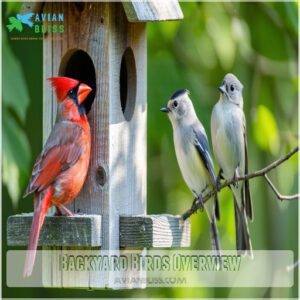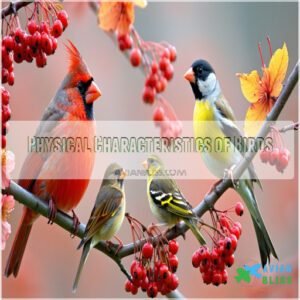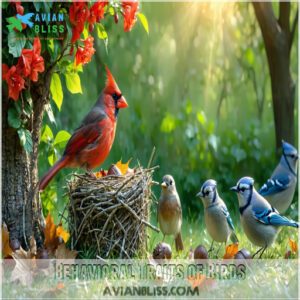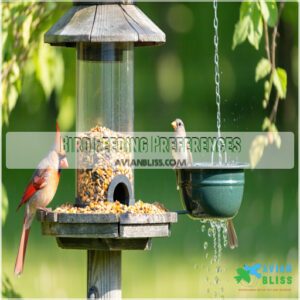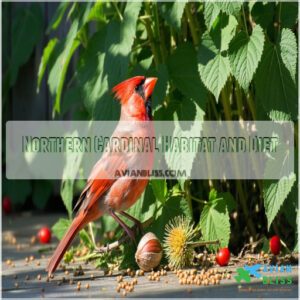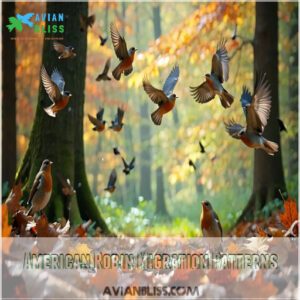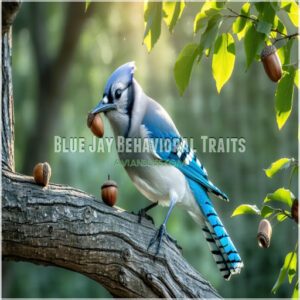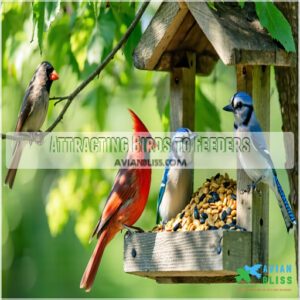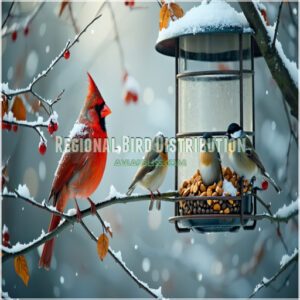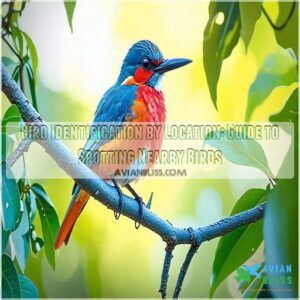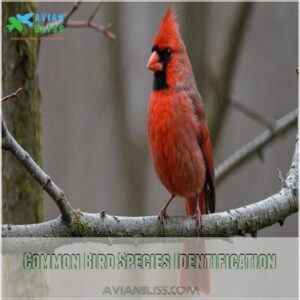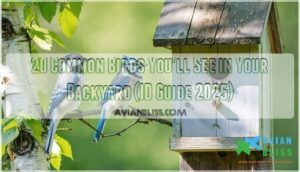This site is supported by our readers. We may earn a commission, at no cost to you, if you purchase through links.
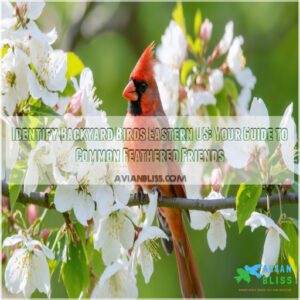
Start with the brightest stars – Northern Cardinals flash brilliant red, while Blue Jays sport distinctive blue-and-white patterns.
American Robins, with their orange breasts and dark backs, are regular guests year-round.
Watch for size, shape, and unique markings like the cardinal’s pointed crest or the jay’s bold wing patterns.
Listen for their calls too – each species has its own voice.
Understanding their feeding habits can make identification even simpler, as each bird shows particular preferences at your feeders.
Table Of Contents
- Key Takeaways
- Backyard Birds Overview
- Bird Identification Tips
- Eastern US Bird Species
- Attracting Birds to Feeders
- Regional Bird Distribution
- Frequently Asked Questions (FAQs)
- How can I identify the birds in my backyard?
- How do I find out what birds are in my area?
- Is there a free app that identifies birds?
- Is there a website to identify birds?
- How do birds communicate with others in backyard?
- Can backyard birds remember human faces and interactions?
- What time of day are birds most active?
- Why do some birds disappear during rainstorms?
- Do backyard birds return to same nesting spots?
- Conclusion
Key Takeaways
- Focus on size, shape, colors, and unique markings like the cardinal’s crest or the robin’s orange chest to identify birds in your backyard.
- Pay attention to bird behaviors like feeding habits, flocking patterns, and nesting locations for easier identification.
- Offer diverse food options like sunflower seeds for cardinals or mealworms for robins, and use the right bird feeders to attract specific species.
- Keep feeders clean, place them near shrubs for safety, and maintain them regularly to support healthy bird populations.
Backyard Birds Overview
You’ll find a surprising variety of birds right in your backyard, from colorful songbirds to curious crows.
Learning to recognize these common species helps you appreciate their unique behaviors and habitats across the Eastern U.S., which is a key part of understanding their role in the ecosystem, and to recognize these birds is to learn about their habitats.
Common Bird Species in Eastern US
Eastern US birds like Northern Cardinals, American Robins, and Blue Jays bring color and life to backyards.
Notice their feather colors, beak shapes, and flock behavior for better bird identification.
These common backyard birds have unique nesting habits and diets. Learn about these common eastern backyard birds including the Northern Cardinal, known for its bright red plumage.
Tracking bird migration helps spot seasonal arrivals, making your backyard a hub for diverse bird species all year.
Year-Round Resident Birds
Some backyard birds stick around all year, making them reliable sights in the eastern US.
These year-round resident birds, like the Northern Cardinal and Blue Jay, thrive in varied habitats, including urban spots.
Look for bright feather patterns or familiar calls. Providing seeds and maintaining nearby nesting sites keeps these common backyard birds nearby for easy bird identification throughout the seasons, with a focus on easy bird identification.
Migratory Bird Patterns
Bird migration in the eastern US depends on habitat shifts and seasonal movements.
Birds follow flyway routes, influenced by weather and food availability.
Key migration cycles include:
- Early movers like American robins heading south as snow melts.
- Birds tracking warmer climates for insects.
- Northern flocks seeking food-rich areas.
- Migratory birds adapting to North America’s changing seasons.
Understanding American robin migration patterns is essential for bird enthusiasts, and learning about American robin migration can provide valuable insights into bird enthusiasts and migration patterns.
Bird Identification Tips
When identifying backyard birds, focus on their size, shape, colors, and unique markings.
Pay attention to their behaviors and feeding habits, as these clues can help you tell one species from another.
Physical Characteristics of Birds
To identify birds, focus on beak shapes, feather colors, wing patterns, and plumage types.
Bird sizes vary—compare a tiny wren to a large crow.
Look for unique field marks, like the cardinal’s crest or the robin’s orange chest.
Using a bird identification guide can be invaluable. A good bird guide helps match these traits to backyard birds, making identification easier and fun!
Behavioral Traits of Birds
How do birds behave in your yard? Observing their habits is key to bird identification.
- Bird Socialization: Some, like crows, are highly social and form tight flocks.
- Flocking Patterns: Watch robins forage in groups during migration.
- Nesting Habits: Cardinals nest low in shrubs.
- Foraging Strategies: Jays cache seeds for later.
- Migration Routes: Robins follow predictable seasonal paths.
Bird Feeding Preferences
Understanding bird feeding starts with Seed Selection.
Eastern US birds like cardinals love sunflower seeds, while robins prefer fruit or mealworms.
Use different Feeder Types—platform feeders for doves, tube feeders for finches.
Food Placement matters too; keep feeders safe from predators.
Smart Feeding Strategies, like cleaning bird feeders often, keep backyard birds healthy and coming back for more.
Eastern US Bird Species
You’ll find a variety of fascinating bird species right in your Eastern US backyard, each with unique traits and habits.
From the vibrant Northern Cardinal to the curious Blue Jay, these feathered friends are easy to spot if you know what to look for.
Northern Cardinal Habitat and Diet
Spotting a Northern Cardinal in your yard feels like a gift.
These backyard birds thrive in the eastern US, favoring dense shrubs for nesting.
Their seed preferences include sunflower and millet, but they’ll also enjoy berries and nuts.
Adaptable in habitat selection, their feeding habits show diet variations, making them a joy to attract with diverse food options.
American Robin Migration Patterns
American Robins are backyard birds known for their seasonal patterns.
In the Eastern US, they shift from lawns to trees, hunting berries during winter.
Their migration routes stretch across North America, with flocks heading south for warmth.
Bird tracking shows they prefer habitats with food and shelter, making them a common sight in diverse robin habitats year-round.
Blue Jay Behavioral Traits
Blue Jays are clever, loud, and full of personality.
In the eastern US, they thrive with their varied Blue Jay diet of seeds, nuts, and insects.
They exhibit fascinating blue jay behaviors, including complex communication and social interactions.
Known for their Jay social structure, they often work in groups to forage and warn others of danger.
Their nesting behavior is diligent, and their bird communication involves sharp calls that echo across North America.
Attracting Birds to Feeders
You can attract a variety of birds to your yard by offering the right food and setting up feeders they’ll love.
Keep feeders clean, well-stocked, and placed in safe, visible spots to create a welcoming space for your feathered visitors, and always ensure they are well-stocked.
Types of Bird Feeders for Northeast Region
Bird feeders are a must for birdwatching in Northeastern North America.
Choose the right type for your backyard visitors:
- Tube Feeders: Perfect for finches and sparrows.
- Hopper Feeders: Versatile, attracting cardinals, chickadees, and more.
- Platform Feeders: Great for ground feeders like doves and jays.
For specific product recommendations, explore the best bird feeders northeast.
Experiment with these bird feeder types to enjoy vibrant feathered guests!
Food Preferences of Eastern US Birds
Eastern backyard birds have varied feeding habits.
Cardinals love sunflower seeds, while doves favor nyjer seeds and cracked corn.
Robins prefer fruits and worms, and Blue Jays enjoy peanuts and suet.
Understanding bird diets helps meet their nutrient needs.
Choosing the right bird feeder types is essential for attracting specific species.
Offering diverse options in bird feeders supports natural foraging strategies, attracting a colorful mix of feathered friends to your yard with the right feeder types.
Feeder Placement and Maintenance
Placing bird feeders matters as much as the food inside.
Keep feeders away from windows to prevent collisions and near shrubs for quick bird escapes.
Regular feeder cleaning with a 10% bleach solution protects backyard birds from disease.
Use sturdy feeder types to deter pests like squirrels.
Maintenance tips? Refill bird seed often, and check for damage to confirm bird feeder placement.
Proper bird feeder placement involves considering ideal feeder placement strategies to attract a variety of bird species, which is a complete concept to keep in mind, and also remember to refill bird seed and use sturdy feeder types to ensure the well-being of the birds, and finally, prevent collisions.
Regional Bird Distribution
You’ll find different birds in your backyard depending on where you live in the Eastern US, with northern states hosting chickadees and juncos while southern regions welcome mockingbirds and cardinals.
Your location’s climate and seasonal patterns also affect which birds you’ll spot throughout the year, as some species migrate south for winter while others stick around as year-round residents.
Some species migrate south for winter while others stick around, which is influenced by the location’s climate and seasonal patterns.
State-Specific Bird Species in Northeast
You’ll spot some remarkable state birds while exploring the Northeast Region.
In Maine and Massachusetts, watch for the charming Black-capped Chickadee, while New Hampshire claims the Purple Finch.
Vermont proudly showcases the melodious Hermit Thrush.
Connecticut shares the American Robin with Michigan and Wisconsin, and don’t forget to look for the striking Northern Cardinal, representing seven states including Illinois and Indiana.
Seasonal Bird Migration in Eastern US
Watching seasonal bird migration patterns unfold in your backyard brings nature’s rhythm right to your doorstep.
You’ll notice distinct changes throughout the year in the Eastern US, with many species following established Eastern Flyways. Birds use several migration navigation methods to complete their journeys.
Here’s what you’ll typically observe:
- Spring arrivals include American Robins and Red-winged Blackbirds (March-April)
- Summer residents like Ruby-throated Hummingbirds settle in (May-August)
- Fall migration brings waves of warblers southward (September-October)
- Winter welcomes Dark-eyed Juncos and White-throated Sparrows (November-February)
Threats to Backyard Bird Populations
While you enjoy watching birds migrate through your backyard, several threats challenge their survival.
Here’s what you should know about protecting our feathered friends:
| Threat | Impact | Solution |
|---|---|---|
| Habitat Loss | Reduces nesting sites | Plant native trees and shrubs |
| Window Collisions | Millions die yearly | Install window decals |
| Predators | Attract natural predators | Use bird feeders with covers |
Your actions matter in bird conservation. By addressing these challenges, you’ll help guarantee birds continue brightening your backyard for years to come, which is crucial for their survival and to keep them migrating.
Frequently Asked Questions (FAQs)
How can I identify the birds in my backyard?
Did you know Northern Cardinals are year-round in 34% of backyards?
Look for their red feathers or brown females.
Use sunflower seeds to attract them, and keep an eye out for Mourning Doves and Blue Jays too!
How do I find out what birds are in my area?
Check local bird guides, use apps like Merlin Bird ID, or observe feeders for common species like cardinals, robins, and blue jays.
Focus on size, color, and behavior to identify them easily.
Is there a free app that identifies birds?
You’ll love Merlin Bird ID! It’s a free app that identifies birds by photo, sound, or description.
Just snap a picture or record a chirp, and it’ll amaze you with instant results.
Is there a website to identify birds?
You can use websites like All About Birds (allaboutbirds.org) or Merlin Bird ID by Cornell Lab to identify birds.
They offer photos, sounds, and tips to help you recognize species in your area.
How do birds communicate with others in backyard?
When birds "spill the beans," they use songs, calls, and body language to communicate.
Songs claim territory or attract mates, while calls warn of predators or signal food.
Wing flutters and postures add extra meaning.
Can backyard birds remember human faces and interactions?
Some backyard birds, like crows and blue jays, can remember human faces and interactions.
They’re surprisingly clever, recognizing friendly gestures or threats, which might make them more trusting—or cautious—depending on your behavior.
What time of day are birds most active?
Early mornings, especially around sunrise, are prime bird activity times.
They’re busy feeding, singing, and defending territories.
Late afternoons also see action as they prepare for roosting.
Midday tends to be quieter, with quieter times in between the busy periods of bird activity not being explicitly mentioned but implied through the contrast of morning and afternoon activities.
Why do some birds disappear during rainstorms?
Rain makes it harder for birds to fly and find food, so they often hide in dense shrubs or trees for shelter.
They conserve energy, waiting for the storm to pass before resuming activity.
Do backyard birds return to same nesting spots?
Many birds, like robins and cardinals, often return to the same nesting spots yearly if the area feels safe.
Keep feeders nearby, avoid disturbances, and they’ll likely treat your yard like home again.
Conclusion
Picture your backyard as a stage, where vibrant birds perform daily.
By learning to identify backyard birds in the Eastern US, you’ll uncover a world of color, sound, and behavior.
Focus on their unique traits—like the cardinal’s red feathers or the robin’s orange chest—and notice their feeding habits to attract them.
Keep feeders clean, offer the right food, and watch nature come alive.
With patience, your yard can become a haven for these feathered friends.

